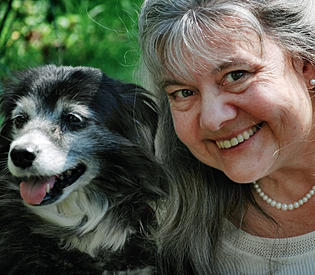Touring around with My Life as a Border Collie: Freedom from Codependency certainly provides me with many opportunities to talk with others about the book and to imagine various ways the book could be used: individually, in book clubs, for group study, for radio interviews, for conference keynote speaking – are some of the ideas that have been generated through conversations. Just the other night at Fountain Bookstore in Richmond, VA this type of inspiring conversation happened for me as I spoke with Kelly Justice, the owner.
I am grateful for all of these ideas and the interest and encouragement which is being expressed to me through them. I enjoy a good conversation, and I can easily both see and get excited about possibilities. In My Life as a Border Collie I write about this type of excitement and energy I am blessed with in chapters on Tenacious and Delighted. And in those same chapters which honor these qualities of excitement and energy, I also write about not letting those features go too far so that they don’t cause me problems in my relationships with others or with my self.
Being disappointed could be one of those hurtful consequences if I don’t pay attention to my excitement and not let it run away with me. In fact what I also want to be able to do as I experience the possibility of things is to let them go.
I continue to deepen my work in this area and am using Let Go by Fenelon as a daily meditation book. Someone gave me this book many years ago, and I recently uncovered it as I was cleaning out a stack of stuff at home. I knew as it came into my hands that this is a great time for me to read and be with this material.
Here is a reading from just the other day that I find very useful in my letting-go practice:
“Learn to cultivate peace. And you can do this by learning to turn a deaf ear to your own ambitious thoughts. Or haven’t you yet learned that the strivings of the human mind not only impair the health of your body, but also bring dryness to the soul. You can actually consume yourself by too much inner striving. And to no purpose at all! Your peace and inner sweetness can be destroyed by a restless mind. Do you think that God can speak in those soft tender accents that melt the soul, in the midst of such inner confusion as you permit by that endless, hurrying parade of thoughts going through your mind? Be quiet, and He will soon be heard . . . ” (p. 9).
Be Quiet and Let Go.
In November, I presented a session at the Carolinas Conference on Addiction and Recovery in Morganton, NC. My session was entitled “Working with Codependent Behaviors: Guiding Lights to Recovery.”
I had excellent participants in my session, most were professionals in the field of addiction, many likely in recovery. As we began, I asked why they selected this session on codependency and what they hoped to get out of it. Most responses were client related with desires to learn how to help family members resistant to changing their ways of enabling.
As our session progressed, however, our focus expanded from how to help our clients to how to help our self as we try to help them. I did not ask for anyone in the room to self-identify as codependent, but when you are with a group of professional caretakers there is likely to be a good number of people whose behaviors can be codependent.
And this became clearer as we talked further about our own efforts to fix and change our clients: stories of getting frustrated, of getting upset, of doing things to persuade and convince them to do what we think they should do.
We smiled and laughed at ourselves as we saw how our own codependence wants to fix someone else’s codependence without our even noticing and working on our own codependent behaviors. Such an unproductive and perhaps destructive tangle.
And such an opportunity for growth, at least then in that room, as we saw even more clearly the need to study these guiding lights to codependency recovery first for our Self.



.jpg)





%20-%20Screened%20Porch.jpg)



